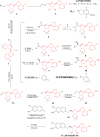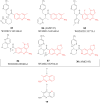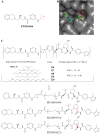A review of the known MTA-cooperative PRMT5 inhibitors
- PMID: 39691229
- PMCID: PMC11650783
- DOI: 10.1039/d4ra05497k
A review of the known MTA-cooperative PRMT5 inhibitors
Abstract
Protein arginine methyltransferase 5 (PRMT5), an epigenetic target with significant clinical potential, is closely associated with the occurrence and development of a range of tumours and has attracted considerable interest from the pharmaceutical industry and academic research communities. According to incomplete statistics, more than 10 PRMT5 inhibitors for cancer therapy have entered clinical trials in recent years. Among them, the second-generation PRMT5 inhibitors developed based on the synthetic lethal strategy demonstrate considerable clinical application value. This suggests that, following the precedent of poly ADP ribose polymerase (PARP), PRMT5 has the potential to become the next clinically applicable synthetic lethal target. However, due to the inherent dose-limiting toxicity of epigenetic target inhibitors, none of these PRMT5 inhibitors has been approved for marketing to date. In light of this, we have conducted a review of the design thoughts and the structure-activity relationship (SAR) of known methylthioadenosine (MTA)-cooperative PRMT5 inhibitors. Additionally, we have analysed the clinical safety of representative first- and second-generation PRMT5 inhibitors. This paper discusses the in vivo vulnerability of the aromatic amine moiety of the second-generation PRMT5 inhibitor based on its structure. It also considers the potential nitrosamine risk factors associated with the preparation process.
This journal is © The Royal Society of Chemistry.
Conflict of interest statement
The authors declare that they have no known competing financial interests or personal relationships that could have appeared to influence the work reported in this paper.
Figures




























Similar articles
-
Discovery of Novel MTA-Cooperative PRMT5 Inhibitors with a 2,3-Dihydro‑1H‑imidazo[1,2‑b]pyrazole Scaffold.ACS Med Chem Lett. 2025 Jun 27;16(7):1313-1322. doi: 10.1021/acsmedchemlett.5c00185. eCollection 2025 Jul 10. ACS Med Chem Lett. 2025. PMID: 40666447
-
Inhibiting PRMT5 induces DNA damage and increases anti-proliferative activity of Niraparib, a PARP inhibitor, in models of breast and ovarian cancer.BMC Cancer. 2023 Aug 18;23(1):775. doi: 10.1186/s12885-023-11260-z. BMC Cancer. 2023. PMID: 37596538 Free PMC article.
-
Research Progress on Small-molecule Inhibitors of Protein Arginine Methyltransferase 5 (PRMT5) for Treating Cancer.Curr Top Med Chem. 2023;23(21):2048-2074. doi: 10.2174/1568026623666230712120527. Curr Top Med Chem. 2023. PMID: 37438905
-
Medicinal chemistry insights into PRMT5 inhibitors.Bioorg Chem. 2024 Dec;153:107859. doi: 10.1016/j.bioorg.2024.107859. Epub 2024 Oct 1. Bioorg Chem. 2024. PMID: 39378783 Review.
-
Application and research progress of synthetic lethality in the development of anticancer therapeutic drugs.Front Oncol. 2024 Nov 25;14:1460412. doi: 10.3389/fonc.2024.1460412. eCollection 2024. Front Oncol. 2024. PMID: 39655075 Free PMC article. Review.
Cited by
-
PRMT5 activity sustains histone production to maintain genome integrity.bioRxiv [Preprint]. 2025 Jul 7:2025.07.03.663002. doi: 10.1101/2025.07.03.663002. bioRxiv. 2025. PMID: 40672221 Free PMC article. Preprint.
References
Publication types
LinkOut - more resources
Full Text Sources
Miscellaneous

